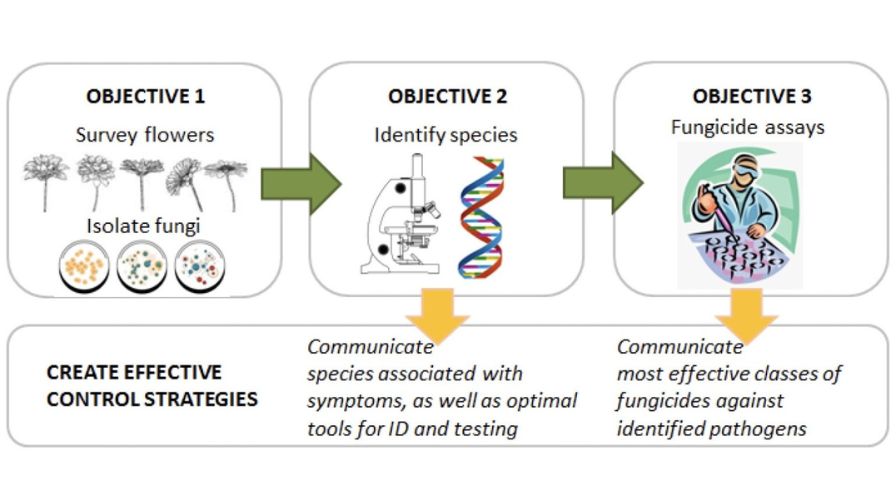
Control strategies graphic on Clemson research | American Floral Endowment (AFE)
Researchers at Clemson University are looking into new ways to control Asteraceae petal blight, a fungal disease that causes specks and streaks to appear on the petals of certain flowers, making them unsellable. Their project seeks to minimize petal blight by finding the most common causal organisms, identifying them, and discovering the most effective strategies to combat them. One year into their project, they’ve given an update on their work and plans for the next year.
The project was created in response to growers in the cut flower industry, particularly those in the Bogota, Colombia area, who face economic losses due to the occurrence of petal blight. Frequently, specks and streaks appear on ray florets of Asteraceae flowers (gerbera, sunflower, chrysanthemum), rendering them unsellable. Growers have reported that Itersonilia sp. has been the most common causal agent, but this diagnosis is based on symptoms that can be easily confused with other causal organisms. The goal of this research is to minimize petal blight by identifying the common causal organisms, facilitating their identification, and generating effective fungicide application strategies.
Specific objectives, based on questions raised by industry growers, that the team is currently addressing as part of the project are to:
- Determine if the Itersonilia that affects mums, gerbera daisies, and sunflowers is all the same species or if a unique species or strain infects each host species.
- Differentiate symptoms from species of Botrytis, Stemphyllium, and Alternaria for identification by staff in the greenhouse.
The development of proper morphological and molecular identification of the microorganisms will be useful to avoid misdiagnosis and fine-tune disease management practices. These large growers have excellent research teams and facilities, with the capabilities to identify organisms with both microscopy and fundamental DNA sequencing methods. Accurate pathogen identification, knowledge of the disease cycle, and appropriate fungicide testing and application will improve control methods.
This past year, the researchers obtained a total of approximately 150 pounds of cut flowers from three growers in the Bogotá, Colombia area. Samples included a variety of cultivars of gerbera, sunflower, and chrysanthemum, in addition to hydrangea. These were sent in response to growers scouting and noticing symptoms and the team’s availability to process them. From these samples, photographs of the symptoms were taken and cultivars were noted. Fungi were isolated using a brief rinse in 70% ethanol and water to remove potential saprotrophic organisms, and samples were plated on malt extract agar and corn meal agar containing antibiotics. Approximately 80 pure cultures are being maintained.
For molecular identification, 30 representative cultures were selected. DNA was extracted from these, and amplification of the internal transcribed spacer region (ITS1, ITS4) was performed for DNA fingerprinting. The researchers sequenced additional regions, starting with the large subunit ribosomal RNA gene, to strengthen or clarify identifications. For the sake of reporting correct information, the identifications of these isolates are not being reported until they are confirmed with almost 100% consensus through one or multiple sequences.
The Clemson University researchers have an efficient system for processing flower samples to record symptoms and isolate associated fungi and the team is ready to process the next season of samples. Generated data will be of use to growers throughout the area and potentially wherever environmental conditions are favorable for the pathogens. The goal is to characterize symptoms with specific pathogens. The researchers will continue to characterize symptoms and identify fungi involved until they can unite the two together.

